Get a free estimate
If you have questions about our services, plans, or pricing we are here for you. Fill out the form below and we will communicate with you by email (and of course provide you with a free estimate).
FEBRUARY 15 2022 /
Thirty years ago, you didn’t hear much, if anything, about ticks. Kids went about their springs, summers, and falls dashing through the woods and jumping in leaf piles with nary a worry.
Unfortunately, when it comes to ticks, a lot has changed in the past three decades. Tick populations seem to grow with every passing year and so too does the threat of contracting a tick-borne disease.
If you want to learn more about ticks, the threats they cause, and how to maintain effective tick control around your Baltimore home, look no further than our complete guide. Here you’ll find all the information you need to protect yourself and your family from these harmful pests.
Ticks are small, parasitic pests. As part of the arachnid family, they have four sets of paired, jointed legs and lack the antennae you find on insects. There are 90 different species of ticks found in the US, but far fewer are common in Baltimore.
The six that you are most likely to encounter in Maryland are the black-legged deer tick, American dog tick, brown dog tick, Lone Star tick, Gulf Coast tick, and Asian long-horned tick.
While all ticks are similar in appearance, they do have some small differences that help differentiate them from one another.
Their similarities are in their flat, oval-shaped bodies that swell when engorged after a feeding, their legs, and their segmented bodies. Their main differences are in their size and coloring:
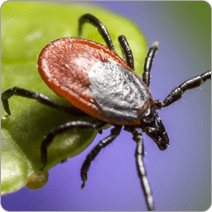
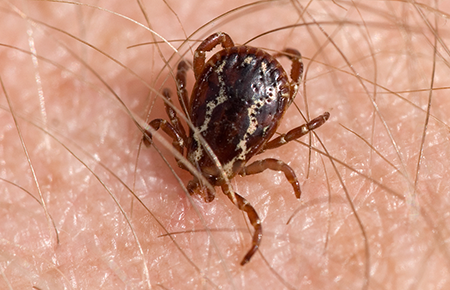
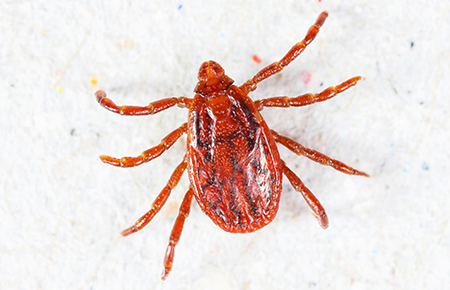
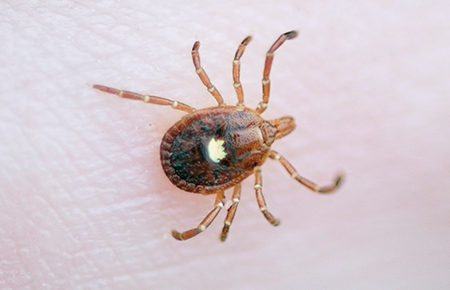
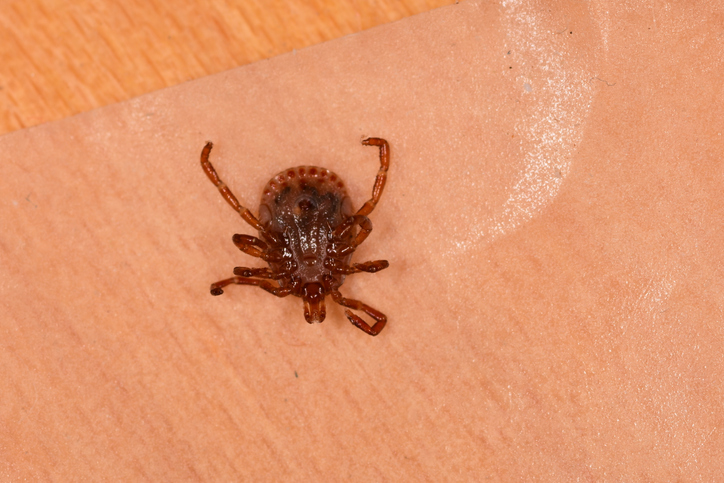
As parasitic pests, ticks require a host to supply them with the blood meal they need to survive. Most ticks choose different types of hosts in each stage of development and will feed on mammals, birds, reptiles, and amphibians.
Ticks become dangerous when they pick up diseases during their feedings.
For instance, if a tick feeds on an infected mouse during the larval stage, then attaches itself to a human for a blood meal during the nymph stage, it can transmit that disease to the human host through infected saliva.
Ticks are known to spread many serious, chronic, and sometimes fatal illnesses. The types of diseases you can get from a tick vary with the type of tick, but include all of the following:
Many of these illnesses are difficult to diagnose because of their general flu-like symptoms in the early stages.
If you did not see a tick on you, you may not suspect a tick-borne illness and assume you’ve just caught a short-term virus. However, if not treated, some of these illnesses can cause a variety of serious long-term problems. In extreme cases, they can even lead to death.
Tick bites aren’t necessarily common for most of us and it can be hard to know what to do when these parasitic arachnids sink their heads into your skin.
But there is a certain procedure you should follow if bitten by a tick:
Finding a tick on your clothing or, worse, on your skin, doesn't mean you have an infestation.
If you've recently been outside in a location where a tick could have gotten on you, you may be able to discard the one tick and be done with it. Here are a few factors that are an indication that this is more than just a single isolated event:
Do You Have Pets?
If you have a dog or cat that goes in and out of your home on a regular basis, it is less likely that your tick encounter is isolated.
Check your pet(s) for the presence of ticks. When ticks get on an animal, they will usually work their way to the ears or hide under your pet’s collar. They may also feed in the groin area or between the toes of your pet.
Have You Been Seeing Signs of Rodents Inside?
Mice, rats, and other wild animals can bring ticks into a home. If you have critters in your home, it is likely that you have more than one tick as a single mouse can have as many as a hundred ticks on its body.
Do You Have a Brown Dog Tick?
Of all the tricks that can get into a home, the brown dog tick is arguably the worst because these ticks are able to complete their entire life cycle indoors.
That means you can have an infestation of brown dog ticks take root after just one or two ticks invade your home.
These ticks could be brought into your home if a visitor brings their pet with them or if you have pets living in your home. Brown dog ticks prefer to feed on dogs, as their name suggests. But, they will turn to humans if they can't find a canine host.
While cold temperatures can affect ticks, cold weather doesn't have as much of an impact on ticks as humidity does.
In states that get more humidity, ticks thrive. For this reason, tick populations are larger in states that are on the East and West coasts.
The coastlines are also where incidences of tick-borne diseases are the greatest, in particular, Lyme disease in humans and dogs, with a concentration of cases being in the northeastern U.S. from Virginia to Maine.
This is why ticks are a serious problem in our DMV service area. The weather in Washington D.C., Maryland, and Virginia is warm enough for ticks to be active most of the year and moist enough for them to thrive.
Over 90% of Lyme disease cases occur in the Mid-Atlantic region, including Maryland. It is estimated that 75 percent of reported Lyme disease cases are contracted in residential backyards. Use these tips to prevent ticks in the yard and keep your family safe.
Did you know that by using Cedar mulch you can naturally repel ticks and other biting pests from the perimeter of your home?
Add two inches of cedar mulch around the exterior foundation of your home and around trees and boundary areas in your yard--in an effort to help keep ticks at bay.
You can also use cedar oil. Cedar oil is known to cause ticks and other insects to die by dehydration. It also liquefies their body fats and interferes with the pheromones responsible for attracting a mate.
You can use an empty bottle-sprayer specifically for gardens and mix cedar oil with distilled water as an effective repellent.
It lasts about 2 weeks, depending on rain and weather conditions. While this is a DIY treatment option, it takes a lot of work, will have to be applied regularly, and will prove to not be as effective as a yard spray from American Pest
Create at least a three-foot-wide (and 2 inches thick) barrier around your property using wood chips, preferably cedar, gravel, or yard spray from American Pest. You can also just put a barrier around your patios or play equipment.
This will help to restrict ticks from migrating into recreational areas where your family and friends hang out and where children play. Maryland, Virginia, and DC are known for their wooded areas and beautiful, lush, yards backing up to woods.
This is a mindful tip if you are near a wooded area or where deer often frequent.
Ticks, especially larvae and nymphs (which are more likely to transport Lyme disease due to their small size), love to feed on rodents.
Organize your yard to keep those tick transporters away. Keep your firewood neatly stacked in a dry area, preferably in sunlight, off the ground, and away from the home.
Deer Ticks and other ticks that carry Lyme disease love to harbor in damp, shady areas around your yard.
Keep your child's playground equipment, decks, and patios as far away from yard edges and trees as these areas are most likely to be moist and dark.
Whenever possible, place outdoor play equipment in a sunny location that is away from tall grass, brush, and foliage.
Remove any old furniture, garden equipment, or trash from the yard that may give ticks a place to hide. Ticks love shady, moist areas, so mow the lawn to keep it short and keep leaves raked.
Clear tall grasses and brush around homes and at the edge of lawns.
Consider growing these plants that are known as natural deterrents of ticks and other pests such as fleas and mosquitoes. While these plants are believed to deter ticks, they will only keep them out of the immediate area, so this should be used in combination with other tick control methods like American Pest.
Now, If you want to get more serious about keeping these little guys out of your property. Follow these tips:
While tick bites are a fairly frequent occurrence for those that like to spend a lot of time outdoors, they can still pose serious health risks to people and pets.
With your safety and the safety of your family in mind, here are some important facts about ticks that you should be aware of, as well as the misconceptions and myths about these harmful parasitic pests.
1. They Are Related to Spiders.
Scientists would describe ticks and spiders as ‘kissing cousins.’ They are actually more related than ticks are to insects.
Ticks may be mistaken as insects because, in their larval stage, they have six legs. They grow their last set of legs when they transition into their nymph stage.
2. They Cannot Jump, Run, or Fly.
It is a common belief that ticks wait high on treetops and fall on their victims, or that they can jump and run to attach to any host of their choosing.
The truth is, ticks cannot jump, fly, or run. Ticks grasp onto their hosts by waiting in tall grass, bushes, or brush.
They hold on to the plants with their third and fourth pair of legs while outstretching their first pair of legs, waiting to climb onto the host. A tick is very patient and waits for the right host to come along, with some species of tick larvae surviving as much as 540 days without feeding.
3. Ticks Can Live a While Without Feeding.
Even though some species of tick larvae can live up to 540 days without feeding, a blood host is essential for transitioning through and completing its growth cycle.
Once a larva finds a host, it feeds for approximately 5 days then drops off to molt into a nymph. An American Dog tick nymph can live up to 580 days without feeding. Adults can live up to 2 years without feeding.
4. Ticks Can Live Up To 3 Years.
It depends on the species, but it usually takes 3 months to 3 years for American Dog Ticks to complete a life cycle.
The life cycle of the Deer tick takes about two years to complete. A tick's survival and development are dependent on the environment and the availability of hosts. Under favorable conditions, a Deer tick may be capable of developing in less than one year.
5. Females Can Lay Thousands of Eggs at One Time.
Female ticks deposit from 3,000 to 6,000 eggs on the ground, usually in sheltered areas like inside woodpiles, under rocks, and in the crevices of walls and structures.
Immature ticks hatch from these eggs and must feed in order to grow and develop. Male ticks usually die after mating with one or more females, although some may live for several months. Females die soon after laying their eggs in protected habitats on the ground.
6. They Don't Mind Freezing Temperatures.
Blacklegged ticks do not die as a result of cold weather. They will typically find shelter under leaf litter to stay hydrated and hunker down during the winter months.
Once temperatures are above freezing, they climb back onto knee-high vegetation, to wait for a chance to grab onto a passing deer, dog, cat, or human.
While there are many ways you can reduce ticks in your yard, the most effective way to reduce ticks and limit exposure is by investing in professional tick control service.
There are many reasons for this that we will get into below but the most important reason is that a licensed professional knows what products to use, how much to use, and where to apply control products for the best results.
If you have questions about tick control, reach out to us for a free consultation. We'd be happy to give you an overview of how professional tick reduction works.
At American Pest, we offer proven pest control services to help residents of D.C., Maryland, and Virginia to control ticks around the yard—keeping you and yours active outdoors!